|
|
|
|
 |
|
25 Years CD: August 17, 1982 - August 17, 2007 and turned 30 in 2012
| Warning: Thanks to hosting company ARVIXE, my pages on soundfountain.com are in disarray. Arvixe moved the server from Texas to Provo, Utah without warning and without providing the necessary codes, password and server address, while the yearly payment had been made and acknowledged by Arvixe for the period until October 2023. We certainly hope that the inconvenience to you, the visitor, will gradually end as the pages are now hosted in the Netherlands. |
How Does It Work...
Edited image. Oiginal image taken from the brochure issued by Philips in 1981 at the Festival du Son in Paris. The added schematic diagram indicates the functioning of the laser pick up, the conversion, and the amplification of the signal.
The engineers of the world famous Philips Physics Laboratory (NatLab) in Eindhoven start working on digital techniques around 1967. A few years later they research the feasibility of the laser video disc combining images and sound. That brings up the idea of making a laser disc just for music and speech with no images added.
The final outcome is a disc of 12 cm in diameter which is read by a laser beam. The disc has a reflective layer, covered by a non reflective layer with holes of various lengths which measure mere micrometers. These holes represent the recorded music. Only when the laser beam is reflected by the disc, the beam is read by a photo cell and the data which it represents are converted into an analog signal.
The first Compact Disc, as the disc is called, is pressed on August 17th, 1982, in the Polygram pressing plant near Hannover, Germany. In 2007 the format was 25 years old.
Although the resolution of the signal and the depth of the sound are very low in quality, relative to the analog tape and LP, this disc is to be the modern successor of the vinyl long playing stereo gramophone record.
Jump to:
Or press Ctrl + F and type what you are looking for.
History Starts In 1967
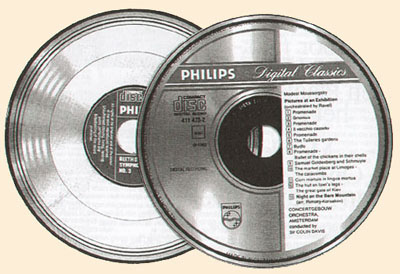 |
Analog Sophistication By the end of the nineteen seventies designers of high end amplifiers are concerned about an extreme large bandwidth, they are investigating all sorts of distortions in order to further improve the reproduction. Not just the values of the Total Harmonic Distortion (THD) and how to handle these, but also the newly discovered Transient Intermodulation Distortion (TIM) and Dynamic Intermodulation Distortion (DIM). Digital formats will make all further research for improvements in these fields practically obsolete. Sound Premonition In the late
nineteen seventies digitally recorded sound is being demonstrated at the
big audio fairs: Funk-Ausstellung (Berlin), CES (Chicago and Las Vegas),
Heathrow (London), Firato (Amsterdam), Festival du Son (Paris), etc.
Digital Fear Many
do fear the arrival of a digital format with such a low resolution.
Especially those who have invested in high end turntables, expensive cartridges,
in tape recorders with professional qualities, in esoteric amplifiers
and grandiose loudspeakers. They have brought the reproduction of the
analog Stereo LP to an extremely high and refined level and are enjoying
pure music, reproduced from records pressed from high grade vinyl with
silent surfaces. |
|
These
are the first lines of an advertisement introducing the CD to the music
loving public. The advertisement appears in Dutch newspapers on the
1st of March, 1983.
The first CD is pressed on August 17, 1982, in the Polygram factory in Hannover, Germany. In Japan the Compact disc is introduced on November 1, 1982. |
Successor to the Stereo LP Thomas
Alva Edison is the inventor of the Phonograph
and the vertical engraving of the signal on a cylinder. It is the so called
hill and dale technique which is later used in a disc proposed by Edison
himself and by Pathé in France. The Beginning In 1966 audio
journalist Leonard Marcus of High Fidelity Magazine investigates
the future of recording in a very interesting article called 'The Prospects
in Audio'. He writes that CBS Laboratories are developing a
new analog disc. It is Dr. Goldmark himself who demonstrates this
new format. It is a 7 inch record with an extremely fine groove. It turns
at 8 RPM and can contain the same amount of information as a 12"
LP. It shows that CBS is a firm believer in their own invention: the analog
long playing record. |
 |
RCA In that same
article in the April 1966 issue of High Fidelity Magazine,
RCA's Dr. Harold Olson tells the readers that the record of the future
will be completely different: ''There will be no music on it, only a binary
code''. He adds that only a very small disc will be necessary. The way
the code will be read is also completely different. No needle or other
mechanical devise will be used. Olson: ''The record could be read by an
electron beam.'' It will be possible to record half an hour of music on
a disc as small as the size of a quarter dollar (according to Wikipedia
the quarter dollar measures 0.955 inches = 24.26 mm in diameter). |
 |
Futuristic In the April
1966 issue of High Fidelity, pianist Glenn Gould writes an essay
on |
Working On The Future
The 1970s: Developing The Standard
 |
Japan Broadcasting Corporation In
1969 the Technical Research Laboratory of the Japan Broadcasting Corp.
demonstrated their digital system known as Pulse Code Modulation which
was looked at with great interest by large electronic companies in Europe
and the USA Billboard reported: "Nippon Columbia (Denon, Ed.) earned
the cooperation of the laboratory and (...) came up with a PCM recording
system which opened the door to noiseless and distortion-free recording." |
 |
Sophisticated Recording Equipment Denon produced
PCM recordings as early as 1973 of artists like pianist Takahiro Sonoda,
pianist Yuji Takahashi, harpsichordist Zuzana Ruzickova, pianist Annerose
Schmidt, pianist Deszo Ranki, pianist Zoltan Kocsis, etc. The recordings
of Mozart's Complete Piano Sonatas by Maria João Pires won several
awards. The specifications
of Denon's PCM recording system:
|
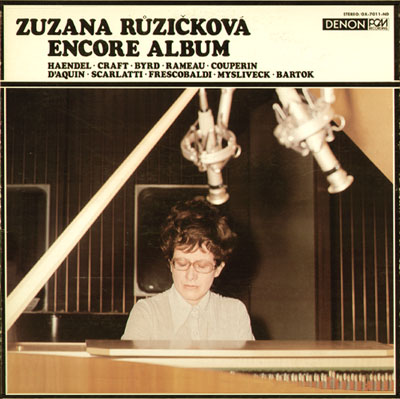 |
Denon (Nippon Columbia) By
the end of 1974 the world wide adopted digital format is the 44.1 kHz/14
bit PCM format. PCM stands for Pulse Code Modulation. The sound
is measured at specific intervals by a pulse. A higher sampling frequency
than 44.1 kHz. and a higher quantization than 14, are not yet feasible.
|
 |
Large Catalog A gradually growing catalog is offered to the record buying public with popular music, jazz, folk, and classical music. The classical recordings feature flute player Jean-Pierre Rampal, the Josef Suk Trio, the Tokyo Metropolitan Symphony Orchestra conducted by Louis de Froment, the NHK Symphony under Otmar Suitner, the Berlin Philharmonic conducted by Kurt Sanderling; pianists Maria Joao Pirez, Anne Rose Schmidt, Vlado Perlemuter, Deszö Ranki; cellist Janos Starker; violinist Josef Suk; organist Helmuth Rilling. From 1982 on many of these recordings are made available on Compact Disc also.
|
|
|
The A & R Department The people
of the Artist and Repertoire Department of the Denon PCM label (Nippon
Columbia) knew well their way around and with taste. One of the many fine
recordings was the performance of Mussorgsky's Pictures from an Exhibition
played by the Tokyo Metropolitan Symphony Orchestra conducted by Louis
Fremaux (X-7072). |
|
|
Denon's PCM LPs Reassessed Above left
you see the cover of LP ST-6007 from 1979. It contains excerpts of the
Denon catalog of PCM recordings. This promotional release and other records
from the nineteen seventies show all to clear the quality of the recordings
made before the advent of the Compact Disc. |
 |
Japan Victor Company - JVC Another developper is JVC, the company known for their consumer products and the CD-4 Discrete 4 Channel Quadraphonic sound recording system. In 1980 JVC's digital format has the standard 14 bits and sampling frequency of 44,056 kHz. At left the cover of The Devil's Trill, a Varèse-Sarabande LP featuring violinist Vlaclav Hudecek and pianist Josef Hala who have been recorded using the JVC VP-1000 Digital recording system. |
 |
Miller & Kreisel and Sony In the beginning
of digital recording Sony U-Matic recorders in conjunction with separate
converter modules are being used. Sony develops the PCM 1600 Digital Studio
Recorder which becomes very popular. When the 1600 becomes available,
more labels start recording digitally. Miller & Kreisel is such a
label. The recordings are made with a Sony PCM 1600 with a sampling rate
of 44.1 kHz. and the dynamic gradation of 16 bits. Jonas Miller and
Ken Kreisel design their own electronics and modify the microphones.
Their objective is to achieve a recording with the least phase shift
and name it M&K RealTime Recording Process. Sony soon replaced
the 1600 by their PCM-1610 Digital Audio Processor, a recording tool that
- if used intelligently - can outperform many a modern low bit processors. |
|
|
Soundstream, Telarc, Digitech, a.o. The producers
and recording engineers of Telarc, and Digitech use a different digital
format. It is devised by Soundstream and has a sampling frequency of 50
kHz. which results in a slightly wider frequency band of theoretically
up to 25.000 Hz. before the phase (time coherent) destroying brickwall
filter comes into action. But what is a high resolution PCM recording
format? The format of the Compact Disc with its 16 bit and 44.1 kHz. or
the 48 kHz. of the digital audio recorder (DAT) can hardly be called high
resolution formats, nor can the Soundstream digital technique. A widfer
frequency band and a higher resolution can only be achieved if two converters
are used as Pioneer demonstrated with their Specifications
for the Soundstream Digital Recording System: Data taken from Digitech DIGI 103 with Anthony Newman on the Historic Hilborne Roosevelt Organ (Great Barrington, Massachusetts.) |
 |
DMS-Delos When the Soundstream system, devised by Thomas Greenway Stockham became available in 1977, the Delos label released recordings with clear and crisp string sound of the Sequoia String Quartet. These performances were masterfully cut and pressed on perfect vinyl. At left the cover of D/DMS 3004 cut in the groove by famous Stan Ricker who was the chief engineer for this recording that was produced by Amelia S. Haygood. Stan Ricker used a transformerless cutting system of JVC and he used Pyral lacquers which were still available in 1979 when these sides were cut. |
 |
CBS Recordings For most recordings CBS used the Sony PCM 1600 converter/video adaptor which was connected to a Sony U-matic video recorder. When the 1610 was available, the sound engineers used that device. Many recordings were mixed and mastered on the CBS DisComputer. There are also a few CBS recordings done using the Soundstream System. The performances of Beethoven's Cello Sonatas Nos. 1 & 2 by Yo-Yo Ma and Emanuel Ax were recorded with the Sony PCM 1600 (CBS D 37251). For their recording of Sonatas Nos. 3 and 5, the Soundstream system was used (CBS IM 39024). And for Sonata No. 4 and Seven Variations WoO, Sony's PCM 1610 was the converter/video adaptor. |
 |
Mixing to Two Channels on the Spot The new digital format confronted any producer and any sound engineer with quite a few difficultes. Apart from the limitations of the digital format, the biggest problem was that multitrack recorders - if available - were very expensive. So the sound picked up by the various microphones had to be balanced on the spot, and the signals had to be mixed down then and there to the two channels of a stereo recording. These signals were then converted by a Sony PCM-F1, or a PCM 1630, and recorded on a U-matic or even a Betamax video recorder. No re-mixing at a later date was possible. That is what "direct to digital" in most cases meant. |
The Industry: Agreements and Demonstrations
16 bit and 44.1 kHz.

|
|
Bandwidth The
chief determining factor of the linear recording system is the sampling
frequency. In case of the CD it is 44.1 kHz. 700.000
Hz. Sampling Frequency Already
in the early nineteen eighties I remember fantasizing with John Watson
(of Mission Electronics at the time) about a very high sampling frequency
of say 700.000 Hz. well knowing that this will result in a high resolution
sound recording. Or take the sampling frequency of 400.000 Hz. as is the
argument of designer Tim de Paravicini in the nineteen nineties. That
frequency will give an audio band extending to 200.000 Hz. This means
that the number of samples at 20.000 Hz. is 8. And this brings about the
resolution of a professional reel to reel tape recorder. Furthermore a
6 dB filter - which is phase coherent - can easily be applied at 20.000
Hz. To some the 200.000 Hz. bandwidth may seem rather far fetched. In
the analog days a basic bandwidth of 400.000 Hz. for sophisticated phono
stages was not at all uncommon. |
 |
Aliasing The format of the linear CD has a theoretical bandwidth of 1 Hz. to 44.1 kHz. In practice however the audio band of 1 to 22.050 Hz. can only be used. The frequency band from 22.050 Hz. to 44.1 kHz. cannot be used. It is the mirror of the 1 H - 22.050 Hz. band. In other words it is the alias. Not a bit of the 22.05 to 44.1 kHz. band shall interfere with the music. In order to prevent a mix up, the insertion of a steep filtering by means of a so called brick wall filter, is applied. In theory the slope of that filter should be 96 dB. That is a very difficult value to implement with an analog filter. That is why sometime later the filtering will take place in the digital domain. This makes it possible to insert a less steep filter in the analog domain. |
|
|
Samples The
number of samples in the audio band is frequency dependent. The lowest
frequencies are being measured many times more than the top frequencies.
The frequencies from about 11.000 Hz. to 20.000 Hz. are sampled only 2
times. |
Linear Format and Oversampling
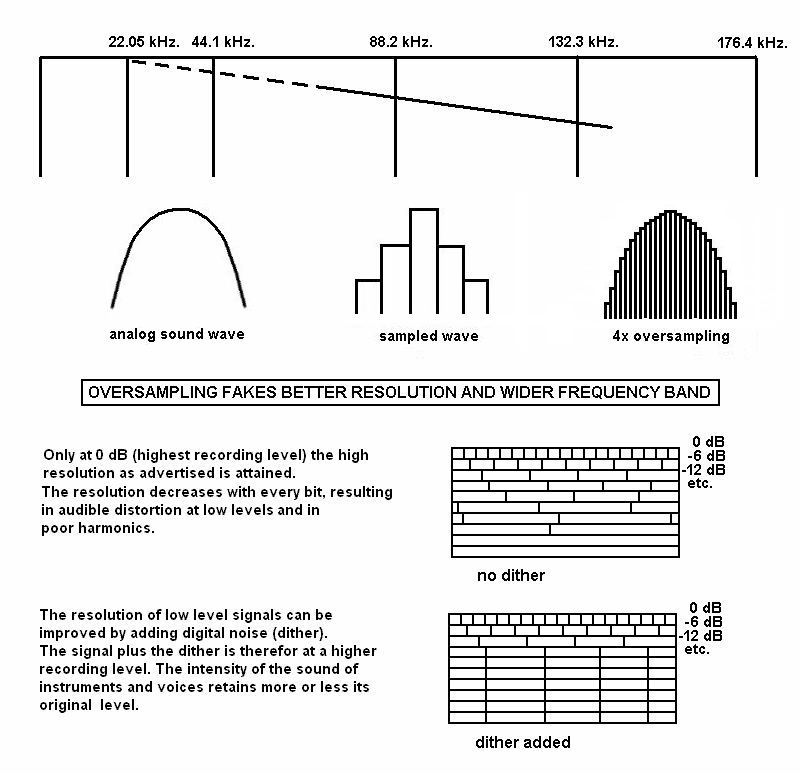
 |
Refining The computer of the PCM recorder has a steep filter otherwise recording was not possible. The same goes for the CD Player. There is however a way to avoid such a filter with a very steep slope. The Philips engineers introduce the so called oversampling. This is a very clever technique. By multiplying the sampling frequency by 4, the sampling frequency will be seen as 176.4 kHz. instead of 44.1 kHz. and an audio bandwidth of 88.2 kHz. is suggested. This also means that the aliasing is far away from the music signal, the actual audio band of 10-20.000 Hz. Yes, 176.4 kHz. would be quite an ideal sampling frequency. Such a high frequency does not need a steep filter. This multiplication has the benefit of "interpolation". Steps between one level (bit) and the next level (bit) are being generated. This results in a more analog like sound wave. |

High Resolution Sigma Delta
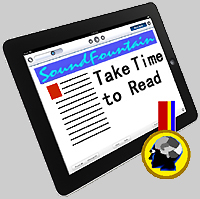 |
High
Resolution Digital There
is another way of devising a digital format. It is a system by which every
frequency is measured with the same sample rate. It is, like the analog
recording technique, a logarithmic sound recording format. That is what
originally is called the sigma-delta method. The name is later used for
high quality linear converters. |

Sophistication
The Versatile LP
|
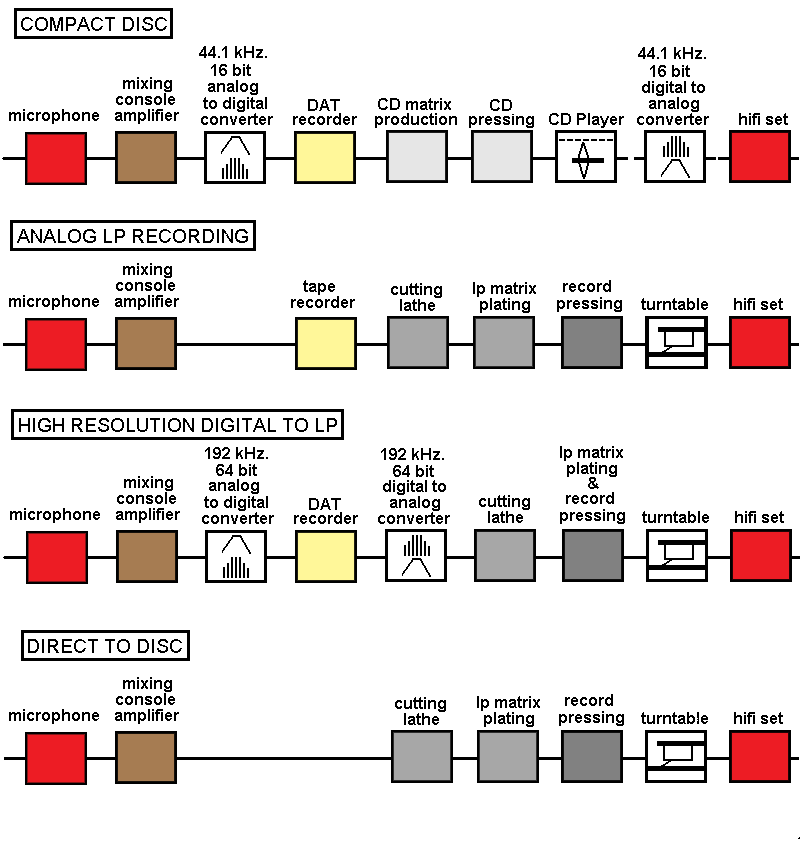 |
|
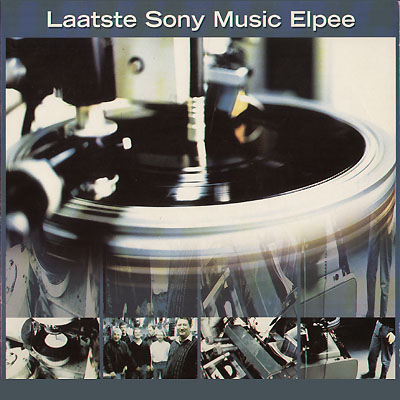 |
Expensive The
analog direct-to-disc recordings are the most expensive and the most
ideal when judging on quality of sound alone. The drawback of the vinyl
long playing record is however that only a restricted number of copies
shall be pressed. A number of 1500 per matrix is the maximum if a relatively
high level of quality is to be guaranteed. Limited
Frequency Band The
restriction of the CD is the chosen sampling frequency which sets the
width of the frequency spectrum of the format. The chosen number of
bits determines the dynamic detail and the depth and harmonic build
up of the sound. The 16 bit and the clock frequency of 7 MHz. of 1982
look rather poor if compared to the 64 bit and 4 Giga Herz. processors
with which modern computers are operating. |
|
|
Analog
LP Record and UDF The gramophone Long Playing record - despite its physical shortcomings - can again demonstrate its versatility. Sound which is originally recorded in a high resolution digital format can be engraved in the analog disc. No need to manufacture a player for that format, unless the UDF-Players of the future can accept extra boards with the appropriate converters. At left the covers of The Last Sony-CBS LP pressed in the Netherlands in March of 1998. The factory was sold and is still pressing some 6 million records a year. The other cover is of digital Philips LP 6570 994 from 1981 including a catalog of the first Philips digital recordings of classical music. |
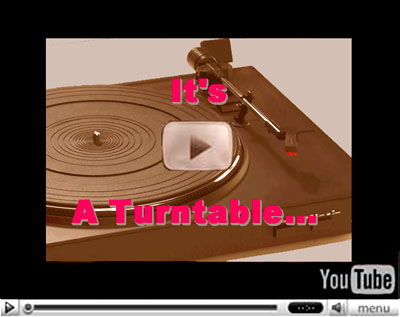 |
The
link at left should lead you to a CBS Sunday Morning report of But
CBS deleted this instructional clip. We regret this immensely as the
report compiled by clever journalist Thalia Assuras was so well done.
After a long time it surfaced again as a somewhat altered video. Also
added hier is the first video originating
from forwardbound's channel on YouTube explaning: Enjoy! |
|
If you want scientific proof of the difference between the frequency range of LP and CD you may want to view The VWestlife Experience on YouTube. Click on the image at left or click on the link bedlow: And
you may also visit this page later: |
|
|
"In the old ages..."
and see how records were pressed in the early and mid 1950s. |
|
|
Cut your own records? If you are technical and musical and you have a few dimes to spare, you can do that today. Visit
|
©
Rudolf A. Bruil.
Page first published on August 17, 2007.
This is the translation and adaptation of an original article,
written in Dutch and published in the Spring of 1993.
Home
| Audio & Music Bulletin | SACD
The Sound of Noiseshaping |
LP List | Record Cleaning Page
| Ortofon/Decca/Tannoy Cartridges |
The Remington Site | Record Stabilizer Ring
| Record Weight | Links
|
|
|